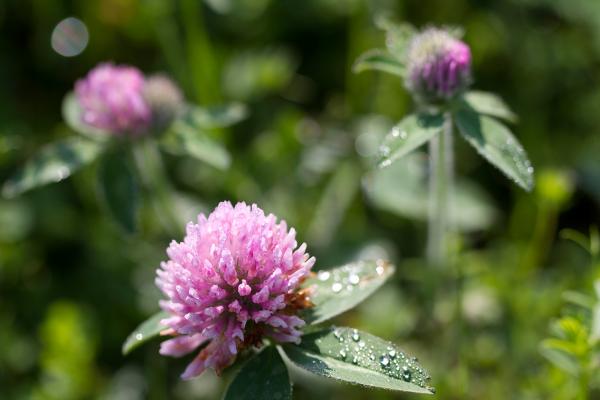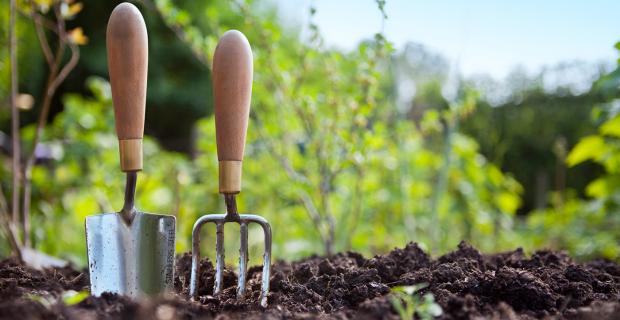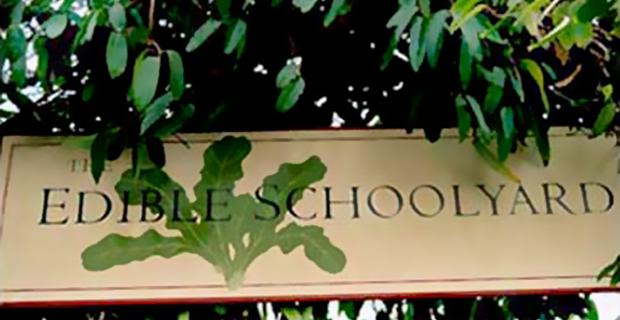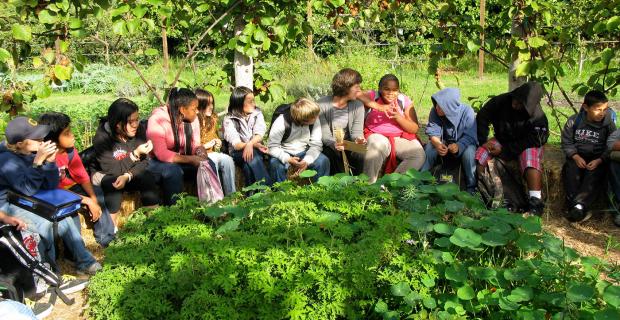"So Much Magic around the Garden"

"Why do you want to work here?" asked Cleveland Elementary School's principal, interviewing Mary Schriner for a position as a special education kindergarten teacher at the Oakland, California school.
"Because your school looks like a prison yard, and I'd like to change that," said Schriner. Six years later, Cleveland sports six lovely gardens that serve as real-world classrooms, an ecoliteracy program for all students, community support and recognition, and student research projects that are making tangible changes in the district food program.
For 2010-2011, Cleveland was chosen to serve as a pilot school within a suite of "iconic projects" undertaken by the Center for Ecoliteracy in partnership with TomKat Charitable Trust to systemically address issues of schooling for sustainability, children’s health, and regional sustainable agriculture.
The changes at Cleveland illustrate the creativity that can emerge from making connections within living systems. "This garden is not so much about plants as it is about working on relationships," says Schriner. "It's about community in every way."
Cleveland's garden program developed organically. Schriner began by "just sitting and observing the land, the dead zones on campus, children's faces, the way people moved across the grounds and interacted." She noted a neglected weed-ridden hillside and a class of special education students with a reputation for expressing misguided anger over not having a permanent teacher. "I felt a strong urge," she says, "to connect these two seemingly unpromising places and draw out the life I knew was hidden beneath the surface."
She asked the students a simple question, "What is a weed?" which prompted discussion connecting to their personal lives. "We decided that weeds were things you didn't invite in, that just appeared in your life and you didn't want them there. They take up space, get in the way, suck all your energy. So it's a good idea to remove them." The students thoroughly enjoyed using their energy to remove the weeds. Then they asked, "Now that the weeds are gone, can we plant something we like?" "That's a great idea," Schriner responded. "When you remove something negative in your life, you need to replace it with something positive. I have some perennials and fruit trees we could put here."
Meanwhile, the rest of the students were watching and asking, "What are they doing? Can we do it too?" Their perceptions of the special education class were changing, and they wanted to be part of their positive action and community. The special ed students' self-perceptions were also changing as they found themselves in a leadership role.
Successive classes planted until the hillside and then the whole campus were thriving with diversity, including an orchard garden, an edible vegetable garden, a flower garden, a redwood garden with native plants, a flower/herb garden, and a wildlife habitat garden. One principle guided the development: not designating different plots for different classes. "Possessing individual plots encourages competition and brings about underutilization," observes Schriner. "Sharing the land builds a sense of community and sense of awe for the interconnections and creativity that emerge."
Schriner's devotion and persistence (and willingness to give up preparation times and lunch times to work in the garden) kept the project going, while she welcomed and encouraged allies. Parent Nathan Stephens has led most of the garden construction projects. Neighbor Michael Bowen joined the Cleveland Garden Committee two years before his child ever attended the school. "Family farmer" groups of volunteer parents have watered and tended the garden for the past five summers.
Sarah Stephens, a PTA leader and children's book author, volunteered. Her involvement deepened when she helped organize the PTA response after they learned that the district was planning a campus "modernization" with floodlights, cyclone fencing, and construction that would have obliterated much of the garden work. "It identified something for parents to rally behind," says Stephens. The episode is an example of a phenomenon described by systems-change theorists: an unexpected intrusion creates instability in a system, but leads to the emergence of creative new forms. "I was trying to help people realize that it was a community garden, and it was the moment that we saved it from the construction that it just became a community," adds Mary Schriner.
Meanwhile, Schriner garnered support from local businesses and organizations — vegetable starts from Kassenhoff Growers, soil from Hammond Construction, tools and advice from the Temescal Tool Lending Library, gardening lessons and assistance on intensive gardening and construction projects from UC Cooperative Extension.
Schriner envisioned an "ecoliteracy under our feet" project to allow students to experience ecological concepts while at play. Parent, artist, and garden volunteer Margaret Chavigny created paintings on the playground illustrating the water cycle, plant parts, and a "human sundial" laid out by volunteers, calibrated to the school's exact longitude and latitude.
The entire school participates in the seasonal/agricultural cycles, composting, working the soil, planting, and harvesting. On Vegetable Soup Day each year, kindergartners and first graders harvest and wash vegetables that volunteers make into soup. On Plant Parts Salad day, second and third graders gather and prepare ingredients, make homemade dressing, and play games where they identify plant parts and their functions. On Pizza Day, Garrick Brackbill of nearby Arizmendi Bakery honors fourth and fifth graders with pizza made from school garden vegetables.
Over the years, Schriner encouraged other teachers, "one teacher, one class at a time," to bring their classes into the garden. She circulated newsletters each season, reporting on developments in the garden and opportunities that teachers might want to take advantage of. Assisted by Sarah Stephens, she led classes when asked, helped teachers to get started, or taught alongside them.
In 2009, after attending a Center for Ecoliteracy seminar, Stephens and Schriner proposed a formal Cleveland Ecoliteracy Program, bringing every class to the garden twice a month for sessions that they would plan and Stephens would teach. With the support of the Cleveland principal, they presented their proposal to the faculty, which adopted it. The program covers 50 percent of students' science instruction and uses the school gardens as "living libraries" for acquiring ecological literacy, which they describe as "the ability to read the natural world and respond to our part in it." Gardens become a context for understanding and recognizing ecological principles, processes and patterns; analyzing and evaluating human impacts on the web of life; and practicing sustainable living.
Schriner reports that "Turning disappointments into opportunities has become my central spiritual practice as a school gardener." Because Stephens does not have a teaching credential, classroom teachers need to accompany their students to the garden. "At first we thought, 'That's too bad,'" says Schriner. "Then we said, 'This is a great opportunity.' As teachers, we never get the chance to observe our students learning. We see them excel in different ways in this environment, and we get to model the experiential discovery learning process."
The project has also influenced school food for the whole district. While studying food miles in 2009, Mary Loeser's fifth-grade class calculated the distance traveled by various items on the menu and sent their findings to Nutrition Services director Jennifer LeBarre. Learning that the asparagus had traveled 17,000 miles — although asparagus is grown within 200 miles of Oakland — helped inspire LeBarre to contact the California Alliance for Family Farmers, establish a farm-to-school program, and increase efforts to offer fresh, local produce throughout the district. In 2010, Cleveland fifth graders expanded their school food research to include agricultural practices, farm worker issues, packaging, and other ecological concerns.
"I've had many, many moments when I've almost wanted to cry," says Schriner, "because I can feel the community happening, not because of me, but because of the natural world that we're trying to create conditions for at the school. There's been so much magic around the garden that I just have a lot of gratitude."




